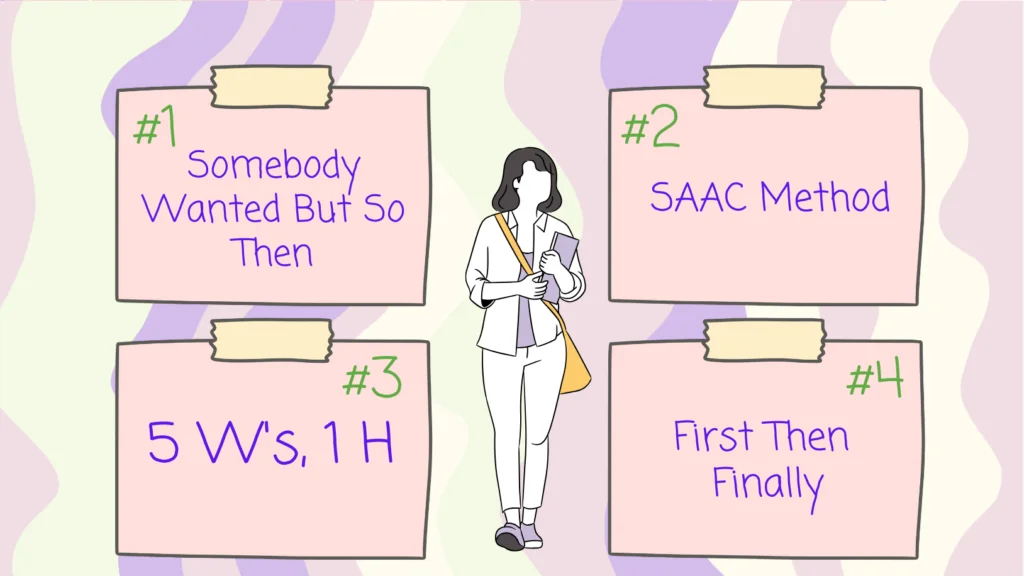Summarizing is a skill that allows you to briefly share the main ideas of a text or a story without retelling it in full detail. It involves distilling the key elements and expressing them concisely. Unlike a full retelling, which recounts every detail, summarizing highlights only the core points, making it a practical tool for quick comprehension and review. And, let’s be honest, no one has time to sift through endless texts nowadays.

✅ AI Essay Writer ✅ AI Detector ✅ Plagchecker ✅ Paraphraser
✅ Summarizer ✅ Citation Generator
Why Is Summarizing Difficult for Some People?
Many students find summarizing challenging because of the sheer volume of information they have to work with, especially in dense texts or complex topics. It can be difficult to pick out the most important points and leave out less necessary details. However, with practice and the right approach, summarizing becomes more manageable, and we’re here to help you with it.
For example, consider a story about a young girl named Emily who spends a summer learning to sail. A full retelling would include every aspect of her experience, from the weather each day to every conversation she had. In contrast, a summary might state: “Over the summer, Emily learned to sail, overcoming her initial fears and eventually entering a competition, which she did not win but gained valuable experience.”
Here’s another example from a historical text about the invention of the printing press. Instead of detailing every event in the inventor’s life, a summary might focus on the key points: “Johannes Gutenberg invented the printing press in the 15th century, a revolutionary development that made books cheaper and more accessible, significantly impacting literacy and education.”
In both examples, the summaries capture the essence of the story or the historical account without delving into every detail. They focus on the main events and outcomes, providing a clear and concise account that retains the most significant information. This makes summarizing a valuable skill for academic success, as it helps students manage information overload effectively and improves their ability to communicate key ideas.
If you struggle with summarizing, consider giving a chance to the new article review generator. The advanced tool by AHelp will analyze the article for you and provide only brief feedback.
Top-4 Summarizing Techniques
The world is your oyster; you can try summarizing the text in any way you want. But sometimes it gets really overwhelming: there are main characters, and then side characters, and then some love triangles, but also the weather is important for context, as well as the place… Where do you even start?!
Not to worry, let’s break down the best summarizing strategies step-by-step, so that you don’t feel lost the next time you’re looking at a lengthy text.

Strategy #1: Somebody Wanted But So Then
The “Somebody Wanted But So Then” strategy is a simple yet effective tool for summarizing stories. This method breaks down a narrative into five key components, helping you capture the flow of a story quickly and clearly.
Here’s how it works:
- Somebody – Identify the main character in the story.
- Wanted – Determine what the main character wants or their main goal.
- But – Describe the main conflict or challenge the character faces.
- So – Explain how the character tries to resolve the conflict.
- Then – Conclude with the outcome of the story.
|
Tim, a young aspiring musician, wants to win his school’s talent show. But, he is nervous about performing in front of a large audience. So, he practices daily and seeks advice from experienced musicians. Then, on the day of the show, Tim performs confidently and wins second place.
In this example:
|
This strategy helps students understand and summarize stories by focusing on the narrative’s core elements. It’s particularly useful for younger students or those who struggle to identify the key points in complex narratives, because we know how overwhelming it can get.
Strategy #2: SAAC Method
The SAAC Method is a structured approach to summarizing that focuses on four key aspects of a story: Setting, Action, Affect, and Conclusion. This method helps students grasp the main elements of a narrative and express them in a proper manner.
Setting involves describing where and when the story takes place. Action details the main events of the story. Affect explains how these events impact the characters or the outcome. Conclusion sums up how the story ends or what is resolved.
|
In a small coastal village during the early 1900s, a young girl named Eliza discovers a washed-up treasure chest. The villagers help her open it, revealing antique jewelry and a map. The discovery excites the community and leads them on a hunt for more treasure. They find nothing more, but the initial find enriches the village and strengthens their bond. In this example:
|
This method is effective for students because it provides a clear framework for identifying and summarizing the main components of a story. By focusing on the setting, action, affect, and conclusion, students can create a to-the-point summary that conveys the narrative without getting bogged down by less important details. It’s particularly useful for longer texts where keeping track of numerous elements can be challenging.
Strategy #3: 5 W’s, 1 H
The 5 W’s, 1 H strategy is a straightforward method used to gather essential information about a story or event. This technique involves answering six critical questions: Who, What, Where, When, Why, and How. By addressing these questions, students can effectively summarize a text and capture the most relevant details without unnecessary complexities.
Who is involved or is the main character?
What happened in the story or event?
Where did it take place?
When did it happen?
Why did the events occur, or what caused them?
How did the events unfold or were resolved?
|
Last Saturday, at Greenwood Park, a charity run organized by the local high school raised over $5,000 for cancer research. Over 300 participants, including students, parents, and staff, ran five kilometers. The event was planned to support community health and contribute to a worthy cause.
In this example:
|
This strategy makes sure that students focus on extracting the core facts of the narrative or event. It encourages thoroughness and helps in creating a well-rounded summary. By answering the 5 W’s and 1 H, students learn to focus on factual, straightforward reporting of events, which is…well, the point of accurate and effective summarization.
Strategy #4: First Then Finally
The “First Then Finally” strategy is an effective method for summarizing texts, emphasizing a clear, linear progression of events. This approach helps students organize their thoughts by breaking down a narrative or process into three straightforward steps: the beginning (First), the middle (Then), and the end (Finally). If your story has a lot of subplots that might derive the reader’s attention, “First Then Finally” is a great way to handle all that.
First: Start by identifying the initial situation or the problem. This sets the stage for what is about to unfold. Then: Describe the development or actions that lead from the initial situation towards a resolution. This is typically where the main events or conflicts occur. Finally: Conclude with the outcome or resolution of the situation. This wraps up the narrative or explanation by showing how the events settled.
|
Maria needed to gather community support for the local park’s renovation. First, she organized a meeting to discuss the park’s issues and gather ideas. Then, she and other volunteers distributed flyers and started a social media campaign to raise awareness. Finally, they successfully hosted a fundraising event, which raised enough money to start the renovation. In this example:
|
This strategy not only helps in summarizing stories or processes but also in planning and writing clear, organized narratives or reports. It’s way easier to focus on three main points: the beginning, the development, and the conclusion. This way, students can effectively summarize information in a way that is easy to understand and follow.
FAQ
Follow us on Reddit for more insights and updates.





Comments (0)
Welcome to A*Help comments!
We’re all about debate and discussion at A*Help.
We value the diverse opinions of users, so you may find points of view that you don’t agree with. And that’s cool. However, there are certain things we’re not OK with: attempts to manipulate our data in any way, for example, or the posting of discriminative, offensive, hateful, or disparaging material.